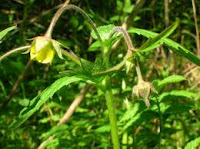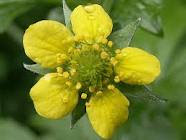Marsh Woundwort is the more usual name for this plant. Although it has been called All-Heal (in mediaeval times) and Clown’s woundwort, with John Gerard, the 16th century English herbalist, claiming that he first called it this. It is a member of the Labiatae or Lamaceae (mint) family and so related to the culinary herbs, marjoram, basil, Holy basil, oregano, savory, thyme, lavender, lemon balm, as well as bugle, motherwort, self-heal, catnip, the chaste tree, ground ivy, Jupiter’s sage, wall germander, Fragrant premna and hyssop. It is a close relative of the Chinese artichoke and wood betony.
 It is native to
It is native to The tubers of this plant are small but edible and it is believed that if the plant were cultivated they would grow bigger, and be a useful food supplement. They were used in Europe prior to the advent of potatoes, and in some countries were eaten as a raw snack up until the 1970s. The young shoots can be cooked and eaten as a substitute for asparagus, but I am not sure if they would taste very good. The tubers can also be dried and ground to make flour for unleavened bread or used in soups.
 In parts of
In parts of There are various records that show that the tubers have been used in times of scarcity as nourishment in Europe until the turn of the 19th century. However the plant was generally used as a wound healer. It used to be made into an ointment with “Hog’s Grease” and also used with goldenrod and fresh butter for wounds. It has also been used for the treatment of gout, stomach cramps and pains in the joints.
Nicholas Culpeper writing his herbal in the 17th century refers to it as clown’s woundwort and has this to say about it:-
“Government and virtues. It is under the dominion of the planet Saturn. It is singularly effectual in all fresh and green wounds, and therefore beareth not this name for nought: And is very available in staunching of blood, to dry up the fluxes of humours in old fretting ulcers, cancers, &c. that hinder the healing of them.
A syrup made of the juice of it is inferior to none for inward wounds, ruptures of veins, bloody flux, vessels broken, spitting, pissing, or vomiting blood: ruptures are excellently and speedily, even to admiration, cured by taking now and then a little of the syrup, and applying an ointment or plaster of the same to the place; and also, if any vein be swelled or muscle cut, apply a plaister of this herb to it, and, if you add a little comfrey to it, it will not do amiss. I assure you this herb deserves commendation, though it have gotten but a clownish name; and whoever reads this, if he try it as I have done, will commend it as well as me. It is of an earthy nature.”
The leaves, stems and roots of this plant have been found to have antibacterial properties by a research team from the University of Strathclyde , Scotland
Who knows, perhaps we will be cultivating it again both for its edible tubers and its health benefits!


























